Mark Sisson's Blog, page 45
June 15, 2021
The Benefits of the Blue Lotus
 Growing up, I was always fascinated by the part in the Odyssey where Odysseus and his men land on an island populated by the “Lotus eaters,” a group of humans who live entirely by eating the fruit of the lotus flower. In the story, some of Odysseus’ men explore the island and encounter the lotus eaters, who offer the sailors some to try. They accept and become addicted to the lotus, wanting nothing but to lie around and nibble on the flowers. When Odysseus comes to retrieve his men, they refuse and weep and try to remain, and he’s forced to remove them from the island and shackle them to the ship until the madness has passed. This part always made me wonder. What was so beguiling about the lotus?
Growing up, I was always fascinated by the part in the Odyssey where Odysseus and his men land on an island populated by the “Lotus eaters,” a group of humans who live entirely by eating the fruit of the lotus flower. In the story, some of Odysseus’ men explore the island and encounter the lotus eaters, who offer the sailors some to try. They accept and become addicted to the lotus, wanting nothing but to lie around and nibble on the flowers. When Odysseus comes to retrieve his men, they refuse and weep and try to remain, and he’s forced to remove them from the island and shackle them to the ship until the madness has passed. This part always made me wonder. What was so beguiling about the lotus?
I had no idea about drugs or addiction or anything of that sort. I was too young. So I assumed it was that the lotus just tasted really, really good.
Turns out that it may have been based on a real lotus flower with psychotropic effects—the blue lotus.
For one thing, the lotus eaters weren’t totally invented by Homer. Herodotus, the famous Greek historian, also wrote about a race of lotus eaters living on an island off the coast of Libya. According to Herodotus, these lotus eaters, or Lotophagi, also made and drank lotus wine.
Two, tons of ancient Egyptian artifacts and artwork depict the lotus, either adorning the heads of gods and goddesses or worn by priests and other figures of great prominence in Egyptian society. We know that the ancient Egyptians cultivated and utilized the Blue Lotus for thousands of years. Their primary mode of ingestion was to steep the flower in wine for several weeks and drink it during celebrations and religious rituals.
King Tut’s tomb, for example, had a gold shrine depicting a figure holding a massive Blue lotus flower, and the tomb of Ramses II contained a wreath of dried blue lotus flowers. You can say a lot of things, but I hardly doubt the flower choice on the pharaoh’s tomb was arbitrary.
In the famous (or infamous) Turin papyrus from ancient Egypt depicting a variety of sexual acts, all the women wear blue lotuses in their headdresses.
The Egyptian Book of the Dead includes several sections discussing the use of the blue lotus in religious rites.
There are similar images found in Mayan artwork, and it’s likely that both the Egyptians and the Mayan civilization utilized the blue lotus for various medicinal applications, including treating erectile dysfunction.https://www.ncbi.nlm.nih.gov/pmc/arti... It also had spiritual significance.
Now, I don’t now if the blue lotus is the same thing Homer was referring to in The Odyssey, but I did uncover some potential benefits to the flower that a group of wayward sailors would have enjoyed.
Technically, you’re not supposed to ingest blue lotus. It’s legal to buy it, but it can’t be sold “for human ingestion.” The fact that it’s been used for thousands of years by a diverse coalition of cultures, that the compounds contained therein have been shown to have beneficial health effects, and that there’s a good chance it was memorialized by one of the greatest authors in one of his greatest works makes me want to dig a little deeper.
There isn’t a lot of modern research into blue lotus itself. No real randomized controlled trials showing an effect (or lack of an effect, for that matter). The literature is fairly bereft. However, there is a fair amount of research into the two primary isolated compounds that we know the blue lotus contains. So let’s take a look at that, see whether the research lines up with what the ancient evidence indicates, and maybe we can make some guesses about the rest of the more “esoteric” claims.
ApomorphineBoth apomorphine and aporphine have been isolated from blue lotus flowers, and for most intents and purposes they are interchangeable, as aporphine is hydroxylated in the body to form apomorphine. Historically, clinicians have used isolated apomorphine as an emetic—a reliable way to induce vomiting.
May Alter Dopamine Function.Apomorphine is a non-selective dopamine receptor agonist, meaning it activates both D1 and D2 dopamine receptors, although it is more active on the D2 receptor. It’s also an antagonist of certain serotonin receptors, and it could inhibit the breakdown of dopamine in the brain in some people. For this reason, some clinicians prescribe subcutaneous or sublingual apomorphine HCL as a treatment for severe Parkinson’s disease (which is characterized by low dopamine activity). When an episode hits, the apomorphine will be applied to reduce muscle stiffness and tremors.
Potential for Psychogenic Erectile DysfunctionApomorphine is also prescribed for psychogenic erectile dysfunction (erectile dysfunction originating from psychological rather than physical issues). It does so by downregulating frontal limbic activity, the site of the brain responsible for “thinking.” In other words, apomorphine may improve sexual function by helping you stop overthinking everything—like the sexual act at hand.https://pubmed.ncbi.nlm.nih.gov/12904...
Could Increase Growth Hormone ReleaseOne study found that in normal, healthy men, apomorphine increases growth hormone (GH) release.https://pubmed.ncbi.nlm.nih.gov/11493... As to whether that also increases the growth of muscle, bone, cartilage, and stimulates fat loss and immune benefits normally associated with GH, it remains to be seen. But by most measures an increase in GH is a good thing, especially since this is natural growth hormone release—not exogenous administration.
May Increase MotivationI know of one men’s clinic that uses apomorphine to treat psychogenic erectile dysfunction who’s found it can also improve motivation. They report patients taking apomorphine for ED end up going to the gym more often, getting over depression, pursuing their goals, and displaying other unintended effects of increasing their dopamine function.
May Increase NGF and GDNFOne study found that isolated astrocytes (a type of brain cell) treated with apomorphine showed increased expression of both nerve growth factor (NGF) and glial cell line-derived neurotrophic factor (GDNF), two pathways that are very important for nerve function, nerve regrowth, learning, addiction prevention and treatment, and dopamine function—to name just a few.https://europepmc.org/article/MED/108...
Could Be Effective as Part of an Addiction Recovery PlanI’ve also heard of apomorphine being used to to help with alcohol and other drug addictions, especially in the old days. A 1977 study details how how out of 123 addicts (about 50/50 alcohol/opiate users) treated with apomorphine, 65% stayed clean for 6 months and 41% stayed clean for longer than 6 months. https://onlinelibrary.wiley.com/doi/a... Those are decent stats. It’s an old study, though. More research is needed. If you’re facing addiction, call the SAMHSA National Helpline at 1-800-662-4357.
May Improve Mitochondrial FunctionAlthough these aren’t in vivo studies, there is evidence that apomorphine can improve mitochondrial function and reduce cell death by inhibiting mTOR (the same pathway fasting, calorie restriction, and keto inhibit).https://pubmed.ncbi.nlm.nih.gov/31356...
NuciferineMolecularly, nuciferine is somewhat related to apomorphine but has divergent pharmacological effects.
May Improve Metabolic HealthThe majority of this research is in rodents, but it’s impressive. Nuciferine has been shown to reduce gut permeability, increase autophagy, and improve gut bacteria composition in rodents fed junk food. As a consequence, the rodents don’t get as fat as they usually do on such a diet.https://pubmed.ncbi.nlm.nih.gov/34018...
Mitigated Damage After Heart Attack in Animal ModelsAgain, in rats: preloading subjects with nuciferine and lotus extract, then inducing a heart attack, spared them from the worst of the health effects. The combo reduced heart and liver inflammation and damage, and it even blocked structural damage and alteration to the heart tissues.https://pubmed.ncbi.nlm.nih.gov/33998...
May Affect Sexual FunctionCombined with two other compounds, nuciferine has been shown to improve erectile dysfunction and premature ejaculation in humans.https://www.pagepressjournals.org/ind...
Has Antipsychotic PropertiesRecently, researchers found that nuciferine interacted with a similar range of receptor sites as conventional antipsychotic medicines. They ran nuciferine through the gauntlet of gold-standard antipsychotic effect tests and found it had broad—albeit atypical—antipsychotic effects.https://www.ncbi.nlm.nih.gov/pmc/arti...
Does Blue Lotus Actually Do Anything?You know my stance on whole foods/herbs versus isolated compounds: the whole is greater than the sum of its parts. It is very likely that the blue lotus flower is both more effective and offers a broader range of benefits than either nuciferine or apomorphine. That’s even more likely to be true for general users of these herbs interested in overall health benefits, rather than someone with late-stage Parkinson’s disease or severe psychogenic erectile dysfunction interested in specific pharmacological effects.
Sure enough, in one study, luciferine by itself was not effective against breast cancer, but an alcoholic extract of the lotus (not blue lotus, but a related species with similar compounds present) was effective.https://pubmed.ncbi.nlm.nih.gov/33602...
Where to get it?I know people in the alternative health world. Some would place me in it. From asking around, I’ve learned that Etsy is a good place to find high quality blue lotus.
How to use it?The most common way to use blue lotus is to make tisane: steep blue lotus petals in boiling water for ten minutes and strain.
I’ve also heard that you can steep blue lotus petals in wine for about a week, strain it, then drink it, to make something approximating what the ancient Egyptian priest and upper castes may have consumed.
What can you expect?From my reading of the literature, here’s what people have experienced.
Calm.If the isolated compounds’ effects on psychosis and muscle spasticity extend to the whole plant, you might expect blue lotus to promote both mental and physical calm.
Focus and motivation.If it indeed promotes healthy dopamine function, blue lotus may improve your motivation and ability to focus.
Sharper mind.If apomorphine’s effects on nerve growth factor and glial cell line-derived neurotrophic factor in isolated astrocytes extend to the brains of people who consume blue lotus, the flower could be fantastic for learning, productivity, and cognitive function in general.
Bedroom benefits.Both nuciferine and apomorphine can have beneficial effects on sexual function, and we know that blue lotus itself had a strong reputation as an aphrodisiac. I find this to be a likely benefit.
Contact with the spirit realm.Well, that’s not guaranteed, but it certainly was used in religious and spiritual rites for thousands of years. Your mileage may vary.
That’s about all I have for the blue lotus.
In the future, I may try the stuff myself and report back—probably on a Sunday with Sisson (sign up for that if you haven’t already).
I’d be curious to hear if anyone out there has tried it. If so, what did you notice?
References https://journals.plos.org/plosone/article?id=10.1371/journal.pone.0216643https://scottbarrykaufman.com/wp-content/uploads/2016/11/Hanley-Garland-2016.pdfhttps://journals.physiology.org/doi/full/10.1152/jn.00551.2017https://bmcpublichealth.biomedcentral.com/articles/10.1186/1471-2458-13-407https://www.ncbi.nlm.nih.gov/pmc/articles/PMC2930158/https://pubmed.ncbi.nlm.nih.gov/24327764/https://www.ncbi.nlm.nih.gov/pmc/articles/PMC5885810/https://www.ncbi.nlm.nih.gov/pmc/articles/PMC4932063https://www.ncbi.nlm.nih.gov/pmc/articles/PMC1697802/https://www.ncbi.nlm.nih.gov/pmc/articles/PMC6937872/https://www.ncbi.nlm.nih.gov/pmc/articles/PMC5769202/https://www.ncbi.nlm.nih.gov/pmc/articles/PMC3665208/https://www.heartindia.net/article.asp?issn=2321-449x;year=2014;volume=2;issue=1;spage=15;epage=18;aulast=Raghavendrahttps://www.theyogicjournal.com/pdf/2018/vol3issue1/PartP/3-1-155-430.pdfhttps://www.semanticscholar.org/paper/Effect-of-Trataka-on-blood-pressure-of-college-Bhadra-Chatterjee/004170708aeee32a41d7b6d43c2f3f334a19a94fhttps://www.ncbi.nlm.nih.gov/pmc/articles/PMC1079300/https://pubmed.ncbi.nlm.nih.gov/12904807/https://pubmed.ncbi.nlm.nih.gov/1149303/https://europepmc.org/article/MED/10872797https://onlinelibrary.wiley.com/doi/abs/10.1111/j.1360-0443.1977.tb00666.xhttps://pubmed.ncbi.nlm.nih.gov/31356884/https://pubmed.ncbi.nlm.nih.gov/34018523/https://pubmed.ncbi.nlm.nih.gov/33998037/https://www.pagepressjournals.org/index.php/aiua/article/view/aiua.2018.1.59https://www.ncbi.nlm.nih.gov/pmc/articles/PMC4786259/https://pubmed.ncbi.nlm.nih.gov/33602253/ (function($) { $("#dfH5J91").load("https://www.marksdailyapple.com/wp-ad..." ); })( jQuery ); 
The post The Benefits of the Blue Lotus appeared first on Mark's Daily Apple.



June 14, 2021
Mastering Motivation Amidst Challenging Life Circumstances
 It seems the hot fitness topic of 2020 is learning how to adapt and stay motivated when your gym is closed, events are canceled, and the awesome motivators of group energy and camaraderie are kept at a distance. Interestingly, some folks have been thrown entirely out of whack, with COVID-19 prompting “the COVID 20” in the same manner as the proverbial Freshman-15. Others have adapted and even thrived when forced to modify their fitness regimens. We can definitely take tips and inspiration from them, but if you are struggling in recent times, don’t stress about it. Falling off your A-game in 2020 doesn’t mean you’re lazy or undisciplined. Personality types who favor tight structure and carefully cultivated environments can really get thrown off. Others who are more self-directed and creative can keep going through all kinds of and obstacles and redirections.
It seems the hot fitness topic of 2020 is learning how to adapt and stay motivated when your gym is closed, events are canceled, and the awesome motivators of group energy and camaraderie are kept at a distance. Interestingly, some folks have been thrown entirely out of whack, with COVID-19 prompting “the COVID 20” in the same manner as the proverbial Freshman-15. Others have adapted and even thrived when forced to modify their fitness regimens. We can definitely take tips and inspiration from them, but if you are struggling in recent times, don’t stress about it. Falling off your A-game in 2020 doesn’t mean you’re lazy or undisciplined. Personality types who favor tight structure and carefully cultivated environments can really get thrown off. Others who are more self-directed and creative can keep going through all kinds of and obstacles and redirections.
My high school running buddy Steve Dietch ran a 2:47 Boston Marathon at age 49 despite an insane international business travel schedule for 200 days a year. New day, new city or country, new running route, new PR—no problem. In recognition of the closure of his gym back in March, 2020, Primal Health Coach (and frequent Primal Blueprint Podcast guest) Dude Spellings of Austin, TX set an hourly alarm on his computer to perform 35 pushups, 15 pullups, and 30 squats. Hit that 6-8 times a day, five days a week, for six months, and it’s easy to see how Dude reports being in his best shape in decades at age 50. Granted, setting an hour alarm and getting the job done to the tune of hundreds of pushups, pullups, and squats every workday is easier said than done. As Sisson says all the time, “If it were easy, everyone would be doing it.” The trick is to discover motivators and environmental triggers that work for you, take baby steps in the direction of your goals and never get discouraged when you fall short of the ideal. Let’s cover an assortment of suggestions that will hopefully make you impervious to distraction, inconvenience or busyness, and allow you to elevate your fitness endeavors into the hallowed category of “automatic” — daily behaviors that characterize a healthy, active way of life.
Cultivate Intrinsic MotivationWhen a goal feels personally meaningful, and when the rewards bolster your sense of who you are or who you want to become, you will likely find it easier to engage in goal-directed behavior, avoid the temptation to stray from the path and be resilient in the face of setbacks. – Lindsay Taylor, PhD
Intrinsic motivation describes doing something to achieve self-satisfaction, while extrinsic motivation describes doing things for external recognition. While intrinsic and extrinsic motivators can undoubtedly complement each other, research suggests that being intrinsically motivated is much more predictive of success and long-term adherence. Dig this quote from MDA’s very own Lindsay Taylor, Ph.D., a social and personality psychologist by training in addition to her role as supermom, keto cookbook author, Ironman triathlete, and Keto Reset Digest queen: “When a goal feels personally meaningful, and when the rewards bolster your sense of who you are or who you want to become, you will likely find it easier to engage in goal-directed behavior, avoid the temptation to stray from the path and be resilient in the face of setbacks.”
Cultivate deep intrinsic reasons for taking action while leveraging extrinsic motivators with a healthy perspective. Go ahead and strive for results, but focus on the process and release the attachment of your self-esteem to the outcome. Sisson tends to draw giggles when he touts “LGN” (Looking Good Naked) as one of the major benefits of a primal lifestyle. But it’s not really a joke. Sure, everyone wants to feel healthy, vibrant, and energetic, experience optimal digestion and elimination, and deliver good blood work. Still, few forces are as powerful as the LGN—whether it’s through the skin you show on Instagram or whether it’s lurking deep in your subconscious.
Create A Winning EnvironmentSet yourself up with success by making it easy to be fit and active. Get all the equipment and apparel you need, keep everything neat, organized, and in top working order, and find convenient and enjoyable venues. This can mean a go-to running or hiking trail, joining a gym that’s easy to get to and has everything you need, hiring a trainer to guide you and keep you accountable, or getting involved with group exercise programs or clubs. Most importantly, set up your home environment to encourage activity. If installing an Endless Pool or converting a bedroom into a rubber-floored home gym is not in the cards, realize that you can create a fantastic fitness experience with extremely minimal space and budget.
Alas, most well-meaning fitness enthusiasts have a bunch of cool stuff in inventory, but it’s often gathering dust in a basement, garage, or closet. The trick here is to arrange your fitness gear so you could pretty much trip over them during your daily routine. You want your kettlebell in plain view, smiling and saying hello in plain sight every time you pass by. Go ahead, paint a smiley face on it! You want your Mini Bands to be as accessible as your rubber bands or paper clips. It’s also great to implement some clever guidelines, incentives, and payoffs to trigger winning behaviors. How about not leaving the office until you accumulate three sets of 20 deep squats throughout the workday? If you were too busy or unmotivated, I guess you’ll have to hit three sets in a row at quitting time.
Beyond my morning routine, I’ll discuss shortly, I’ve established assorted rules and benchmarks for fitness and activity that have become etched in stone—a sign I respect both myself and the importance of being healthy, fit, and active every day. I have a hex deadlift bar loaded with moderate weight, located along my side yard path to the garbage barrel. Every time I take the garbage out, I have to do a minimum of one set. Ditto for when I enter my storage closet with a pull-up bar in the door frame. One set of 12—automatic. I don’t have to question whether I’m motivated or have enough time or energy because it’s only one set. If I’m feeling energetic, I’ll take the opportunity to do a second, third, or fourth set right away or by returning to the apparatus over the ensuing hours. The hardest part here is not completing the tasks, it’s convincing yourself that these seemingly trivial, OCD covenants are actually incredibly important and beneficial in the age of hyperconnectivity, distraction, and our endless pursuit of luxury and decadence.https://hbr.org/2020/01/to-achieve-bi...
Visual cues are an essential part of the picture here.https://www.ncbi.nlm.nih.gov/pmc/arti... The difference between having an X3 Bar strapped up and ready for action versus tucked away in a closet is astronomical. Here’s another comment from Dr. Lindsay: “All of our behaviors are triggered by something, whether we’re conscious of it or not. Keeping your fitness gear out in the open plants a suggestion in your brain that exercise is important, convenient, and accessible right now. It still takes discipline to get started, but once you start, you’ll most likely finish. Even a small obstacle, like having to unpack or set up fitness gear, can make you less likely to do it. Similarly, leaving a plate of cookies on the table makes you more likely to grab one!”
Morning RoutineMy morning flexibility/mobility/yoga/core and leg strengthening routine has been such a life changer that a whole article about it will appear here shortly. First thing in the morning is the best time to build a winning habit that you can leverage into becoming a more focused and disciplined person throughout the day. Some key attributes can make or break your success. First, create a firm commitment to advocate for yourself and complete some kind of mindful movement routine every single day, no matter what. It’s a better energizer than coffee! Second, make your routine short enough to ensure that it’s no problem to complete. On uniquely time-crunched mornings, do a makeup session later in the day. Third, do the exact same thing every day, no matter what, so you don’t have to apply any willpower or creative energy. You can revise your template over time, adding or subtracting exercises as you wish to establish a new fixed routine going forward. Fourth, custom design a routine that works for you and that you enjoy. Perhaps it includes movements that address muscle weaknesses or imbalances, helps you prepare for specific fitness goals, or helps you awaken gracefully. Fifth, add an element of mindfulness where you strive to focus entirely on your breathing or proceeding through the repetition counts for each movement. This will give you a chance to hone your focusing skills and experience a refreshing mind/body connection, something that will be tough to come by as your day gets busier and more fragmented.
The Dog FactorBeing part of something bigger than yourself is a fundamental human desire. This is what fanaticism in sports, religion, social causes, or politics are all about. If you find yourself lacking motivation or consistency with your exercise routine, perhaps you can extend your perspective beyond the whims of your moods, desires, and distractions and do it to honor one of the highest purposes imaginable: the needs and desires of your dog! Establishing a rock-solid accountability partner relationship with a human works here too, but there is something magical about answering to a pet https://www.jconline.com/story/life/w... that has worked for me throughout my life. When you visit the shelter or breeder and make that initial heartstring connection with an animal that you eventually bring home, you are making a solemn vow to care for it for its entire lifespan. This means filling the food and water bowls daily and keeping updated on vaccinations, but it certainly should also mean giving your pet daily access to the outdoors and exercise.
Dogs love routines and have an incredibly acute awareness of their circadian rhythms, so perhaps you can create a habit of getting your pet out at the same time every day? Twice a day would be ideal, maybe a really short outing paired with an extended outing. If you’re not feeling motivated, are facing inclement weather, or are too busy engaged with a screen to make it happen, try gazing into your dog’s eyes and explaining the reason why you can’t make it today. Seriously, try this technique out (we all already talk to our pets anyway!) It can be a highly effective strategy to help change your mind on the spot and get out the door—especially if your dog is inclined to pace around and moan on cue first thing in the morning or around sunset. I always get a perspective reset when I’m fretting about leaving a warm home for a snowy winter trail excursion and watch my dogs go gangbusters out the door and attack the snowdrifts with pure joy. Why can’t it be the same for the soft and overly coddled modern human?
MicroworkoutsAgain, this is such a revolutionary topic that it deserves an entire post. In the context of this article, micro-workouts shine because they don’t require much motivation to complete. When it comes to getting out the door for a dark five-miler after a tough day at work or getting your butt onto a seat for a 6:00 am spin class, low energy and motivation can be a legitimate excuse for mere mortals. But doing one set of kettlebell swings after a long stint at the computer? Or two quick sprints up a flight of stairs after a long meeting in the conference room? These are natural human inclinations that deliver a burst of energy and mood elevation!
To build momentum in this area, find a sweet spot where you can enjoy a quick burst of physical effort, don’t have to strain to total muscular failure or muster the energy for additional sets, and don’t experience any stress over clogging up your busy daily schedule. The anecdote about Dude Spellings doing pushups, pull-ups, and squats on the hour may be too daunting for most people due to the fitness requirement, if not the scheduling logistics, but couldn’t you devote at least one work break per day to bust out robust sets of pushups, pull-ups, and squats? If we were to check back a year from now and you’ve completed one fitness break every single workday, you can imagine the enormous fitness gains this simple commitment can deliver.
Monitor Your Workout Stress
Your subconscious is very good at pushing you away from activities and behavior patterns that cause discomfort and fatigue. This is a genetically hard-wired protection mechanism against breakdown, burnout, illness, and injury. It’s great to open up the throttle once in a while and achieve a fitness breakthrough. Still, many enthusiasts of all ability levels follow workout schedules that are simply too stressful, especially when combined with other stresses in hectic daily life. Thanks to the cultural pressures and manipulative marketing messages that glorify pain and suffering, we have been programmed to disrespect and disregard the subtle and not-so-subtle messages from the subconscious to back off. Advertisements for fitness programming and equipment, sugary beverages, or sexy apparel routinely feature imagery of chiseled specimens sweating and suffering for the great reward of a toned physique. Why jog around the block when you can sprint to the top of the mountain? Consequently, we feel compelled to plug away until we get into a rut and eventually fall apart.
Don’t be that guy or gal! Make sure that your individual workouts and your schedule as a whole are enjoyable, convenient, and feel natural and easy to sustain. Make sure every movement results in an elevated mood, energy levels, and general well-being in the hours and days afterward. Get a simple spiral notebook and make subjective evaluations of your workouts in addition to the statistics and logistics. I’ve been journaling my workouts daily for decades, and it’s been extremely helpful to look back after occasions of burnout or injury and notice the clear warning signs that I was out of balance and heading for a derailment or a full train wreck.
When your workouts are fun, convenient, and energizing, and become an automatic fixture in your daily schedule without needing to willpower, creativity, or extra stress to shuffle other responsibilities, then you don’t have to worry about repeatedly summoning enough motivation to get moving. Instead, things just happen in accordance with your values, beliefs, and personal goals. Good luck, and if you take anything away from this article, it would be to start small and build momentum over time.
(function($) { $("#df66dFZ").load("https://www.marksdailyapple.com/wp-ad..." ); })( jQuery ); 
References https://hbr.org/2020/01/to-achieve-big-goals-start-with-small-habitshttps://www.ncbi.nlm.nih.gov/pmc/articles/PMC4263011/https://www.jconline.com/story/life/wellness/2014/06/17/dog-walking-study/10660843/
The post Mastering Motivation Amidst Challenging Life Circumstances appeared first on Mark's Daily Apple.



June 12, 2021
Smoked Prime Rib Recipe, Without a Smoker
 Making prime rib at home can be intimidating, but we’re going to show you a simple grill-to-oven method that is virtually foolproof. This may become your new go-to recipe when you want to impress!
Making prime rib at home can be intimidating, but we’re going to show you a simple grill-to-oven method that is virtually foolproof. This may become your new go-to recipe when you want to impress!
This prime rib starts on a gas or charcoal grill with wood chips to infuse it with a smoky flavor. If you have a smoker, by all means use that for the smoking portion.
It is then finished in the oven to get a crispy browned exterior and a juicy, medium-rare interior. A variety of wood chip varieties can be used for beef, but for this recipe we like cherry, apple or pecan. For a bolder flavor, you can try hickory or oak.
We highly recommend salting the prime rib the night before and letting it rest in the fridge in a pan with a rack. This will give the meat more flavor and be more tender after cooking. We serve the prime rib along with our Primal Kitchen Steak Sauce.
Ingredients5 lbs. boneless prime ribSalt1/4 cup unsalted butter2 Tbsp. fresh thyme leaves3 Tbsp. chopped sage leaves2 tsp. Black pepper8 cloves grated garlicPrimal Kitchen® Steak SauceDirectionsPat the prime rib dry. Liberally salt your meat on all sides and place it on a rack in the fridge overnight.
The next day, take the meat out and allow it to rest at room temperature for an hour. Melt the butter and mix in the thyme, sage, pepper and garlic.
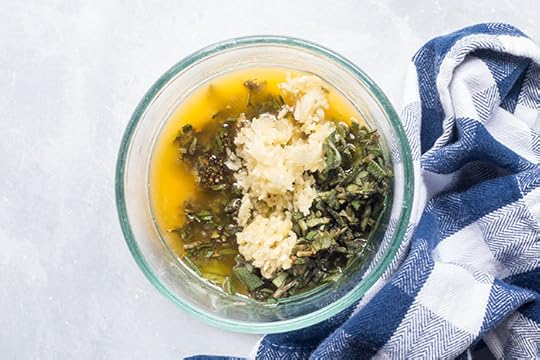 Rub the mixture all over the meat and place it in a cast iron pan. We used a cast iron grill pan since it was too big for our regular cast iron pan.
Rub the mixture all over the meat and place it in a cast iron pan. We used a cast iron grill pan since it was too big for our regular cast iron pan.
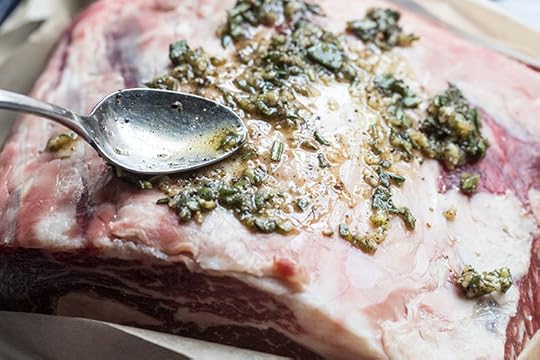

While the meat is resting, soak some wood chips for about 20 minutes. Beef can withstand many types of wood for smoking. Many people like using hickory or oak, but for this we like fruit tree chips like apple, cherry, or pecan.
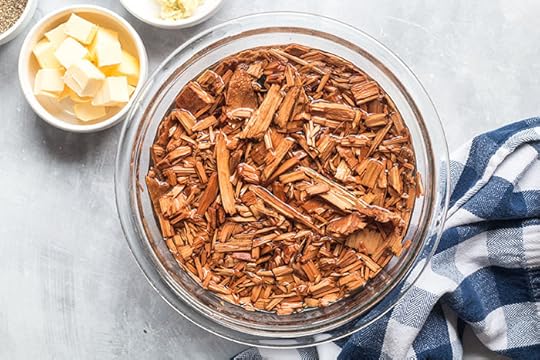
For less than $20, you can purchase a smoker box, which is a metal box with holes that holds wood chips in your grill. Or you can do what I did and make your own smoker out of heavy-duty aluminum foil.
Either way, drain your wood chips thoroughly. Place them in the smoker box or in the center of a large square of foil. Wrap the wood chips in the foil, then use a knife to poke some holes in the top of the foil packet. This will allow fragrant smoke to emanate from the package.
Turn one side of your gas grill on to high heat. Place the foil packet with wood chips on the side that’s heating up. Cover the grill and allow it to come up to temperature and for the wood chips to start smoking. This will take 30 minutes or so.
Once you see a good amount of smoke coming from the foil packet, place the pan with the meat on the opposite side of the grill (the side that isn’t heated up). Cover and allow the meat to smoke for 30 minutes, then flip the meat over and smoke for an additional 20-30 minutes.
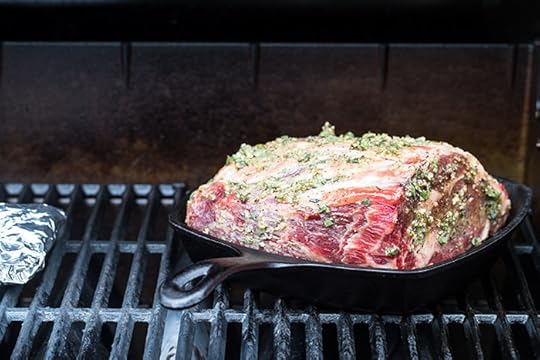
Preheat your oven to 325 degrees. Use a meat thermometer with a heat-safe probe and place it in the center of the thickest part of the meat. Place the pan and meat in the oven and allow it to cook until the internal temperature is reached. Aim for 115-120 degrees for a medium-rare roast. Once the temperature is reached, take the meat out of the oven and allow it to rest for 15 minutes.
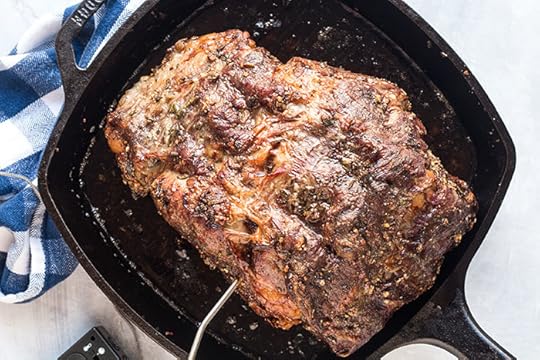
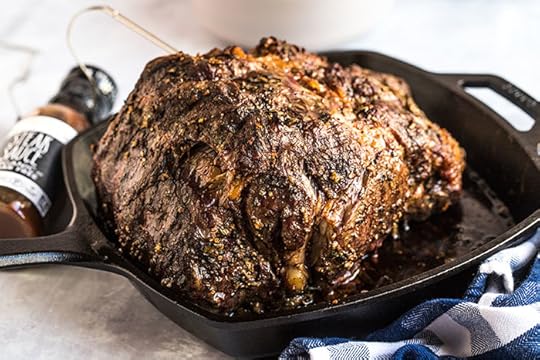
Slice the meat as thick or as thin as you’d like. Top with Primal Kitchen Steak Sauce and serve with your favorite sides.


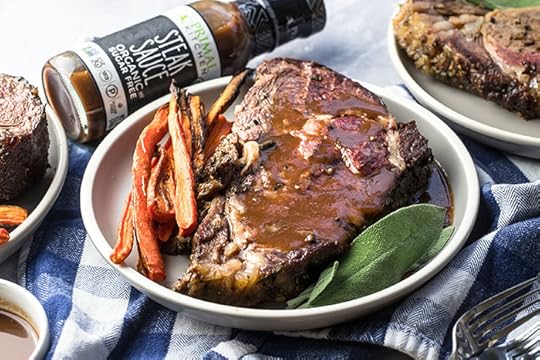

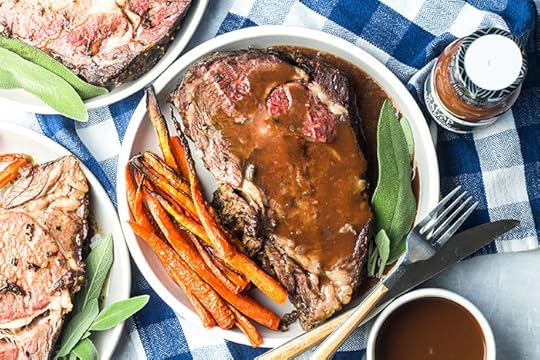

(function($) { $("#dfuFuxA").load("https://www.marksdailyapple.com/wp-ad..." ); })( jQuery ); 
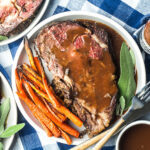 Smoked Prime Rib Recipe, Without a Smoker Author: Mark's Daily Apple
Smoked Prime Rib Recipe, Without a Smoker Author: Mark's Daily Apple  Prep Time: 20 minutes
Prep Time: 20 minutes  Cook Time: 1.5-2 hours
Cook Time: 1.5-2 hours  Total Time: 2-2.5 hours
Total Time: 2-2.5 hours  Yield: 10 servings Diet: Gluten Free
Yield: 10 servings Diet: Gluten Free  Print Recipe
Print Recipe  Pin Recipe Description
Pin Recipe Description Juicy smoked prime rib made in a regular grill without a smoker.
Ingredients5 lbs. boneless prime rib
salt
¼ cup unsalted butter
2 tbsp. fresh thyme leaves
3 tbsp. chopped sage leaves
2 tsp. black pepper
8 cloves grated garlic
Primal Kitchen Steak Sauce
Pat the prime rib dry. Liberally salt your meat on all sides and place it on a rack in the fridge overnight.
The next day, take the meat out and allow it to rest at room temperature for an hour. Melt the butter and mix in the thyme, sage, pepper and garlic. Rub the mixture all over the meat and place it in a cast iron pan (we used a cast iron grill pan since it was too big for our regular cast iron pan).
While the meat is resting, soak some wood chips for about 20 minutes. Beef can withstand many types of wood for smoking. Many people like using hickory or oak, but for this we like fruit tree chips like apple, cherry, or pecan.
For less than $20, you can purchase a smoker box, which is a metal box with holes that holds wood chips in your grill. Or you can do what I did and make your own out of heavy-duty aluminum foil. Either way, drain your wood chips thoroughly. Place them in the smoker box or in the center of a large square of foil. Wrap the wood chips in the foil, then use a knife to poke some holes in the top of the foil packet. This will allow fragrant smoke to emanate from the package.
Turn one side of your gas grill on to high heat. Place the foil packet with wood chips on the side that’s heating up. Cover the grill and allow it to come up to temperature and for the wood chips to start smoking. This will take 30 minutes or so.
Once you see a good amount of smoke coming from the foil packet, place the pan with the meat on the opposite side of the grill (the side that isn’t heated up). Cover and allow the meat to smoke for 30 minutes, then flip the meat over and smoke for an additional 20-30 minutes.
Preheat your oven to 325 degrees. Use a meat thermometer with a heat-safe probe and place it in the center of the thickest part of the meat. Place the pan and meat in the oven and allow it to cook until the internal temperature is reached. Aim for 115-120 degrees for a medium-rare roast. Once the temperature is reached, take the meat out of the oven and allow it to rest for 15 minutes.
Slice the meat as thick or as thin as you’d like. Top with Primal Kitchen Steak Sauce and serve with your favorite sides.
Notes
We highly recommend salting the prime rib the night before and letting it rest in the fridge in a pan with a rack. This will give the meat more flavor and be more tender after cooking.
 Category: Lunch, Dinner
Category: Lunch, Dinner Method: Grilling
Method: Grilling Cuisine: American Nutrition Serving Size: 1/10 of recipe without sauce Calories: 626.4 Sugar: 0 Sodium: 347 mg Fat: 50.6 g Saturated Fat: 20.9 g Unsaturated Fat: 1.52 g Trans Fat: .2 g Carbohydrates: 1.3 g Fiber: .3 g Protein: 42.3 g Cholesterol: 182.2 mg Net Carbs: 1 g
Cuisine: American Nutrition Serving Size: 1/10 of recipe without sauce Calories: 626.4 Sugar: 0 Sodium: 347 mg Fat: 50.6 g Saturated Fat: 20.9 g Unsaturated Fat: 1.52 g Trans Fat: .2 g Carbohydrates: 1.3 g Fiber: .3 g Protein: 42.3 g Cholesterol: 182.2 mg Net Carbs: 1 g Keywords: smoked prime rib, grilled prime rib, smoked meat without a smoker
 Did you make this recipe?
Did you make this recipe? Share a photo and tag Mark's Daily Apple — we can't wait to see what you've made!
The post Smoked Prime Rib Recipe, Without a Smoker appeared first on Mark's Daily Apple.



June 11, 2021
New and Noteworthy: What I Read This Week — Edition 134
 Research of the Week
Research of the WeekOLED is a little better than LED for circadian rhythms, but not by much.
Some gut bacteria metabolize cholesterol.
Plant “milk” leads to iodine deficiency. Cow milk leads to sufficiency.
Men are more likely to make extreme decisions and changes than women.
Episode 498: Cynthia Thurlow: Host Elle Russ chats with Cynthia Thurlow, globally recognized expert in nutrition and intermittent fasting.
Health Coach Radio: Erin and Laura chat with Michelle Knight, personal branding consultant.
Media, Schmedia65 grams of red meat a day is a ridiculous limit.
The importance of biological sex in biology research.
Interesting Blog PostsWhen will we stop “being surprised” that gut bacteria affect neurological function and development?
Does church reduce drug and alcohol abuse?
Social NotesDon’t these foods sound familiar?
Don’t do this, folks. Sound off if squeamish (but a good lesson).
Everything ElseWaking up an hour early may lower depression risk.
Things I’m Up to and Interested In
This is why I fast: Liver gets more insulin sensitive, rest of body more resistant.
Famous last words: “Healthier food.”
Good for them: A member of the FDA’s expert panel resigned over the panel’s approval of an Alzheimer’s drug that doesn’t work, probably harms, and is very expensive.
But sure, modernity is flawless and everything is better than it was: Passengers are too heavy for airplanes.
Incredible: Simone Biles in slow motion.
Question I’m AskingAre you a morning person?
Recipe CornerBeef and sweet potato taco salad.Ginger turmeric ice cubes, a great idea.Time CapsuleOne year ago (Jun 5 – Jun 11)
The Definitive Guide to Protein — All about protein.The Complete Magnesium Manual — All about magnesium.Comment of the Week
“Sun exposure – totally depends where you live. Here in New Zealand you can get seriously sunburnt in about 10 minutes in summer between the hours of around 10am – 3pm, especially if you are pale. You can actually feel the sun burning your skin immediately. I NEVER sit directly in the sun and don’t go into the sun without sunscreen and a hat. We have the highest rates of melanoma in the world.”
-Important comment from Monica.
(function($) { $("#dfhiRw4").load("https://www.marksdailyapple.com/wp-ad..." ); })( jQuery ); 
The post New and Noteworthy: What I Read This Week — Edition 134 appeared first on Mark's Daily Apple.



June 10, 2021
Ask a Health Coach: Pre-Diabetes, Detoxes, and What’s More Important, Diet or Exercise?
 Hey folks! Erin back to answer more of your questions. If you’re struggling to keep your blood sugar balanced, just coming off a 30-day challenge, or want to know the real solution for long-term weight loss, stick around for this week’s post. We love getting your questions, so keep them coming in the comments below or over in our Mark’s Daily Apple Facebook group.
Hey folks! Erin back to answer more of your questions. If you’re struggling to keep your blood sugar balanced, just coming off a 30-day challenge, or want to know the real solution for long-term weight loss, stick around for this week’s post. We love getting your questions, so keep them coming in the comments below or over in our Mark’s Daily Apple Facebook group.
Devin asked:
“I just got blood work done and it came back that I’m prediabetic. I don’t eat much sugar (I’m not a dessert kind of person) and follow a paleo diet about 70-80% of the time, so I’m confused. What else could be at play here?”
Sugar is sneaky. It’s everywhere in our culinary culture and not just in the places you’d expect, like cookies, cakes, and $6 coffee drinks. The average person consumes up to 66 pounds of added sugar per year.https://www.cdc.gov/nutrition/data-st... That’s added sugar, not naturally sweet foods like fruit, or foods that convert to sugar, which I’ll talk more about here in a sec.
Is Prediabetes Bad?When you’re a chronic consumer of sugary foods or foods that turn to sugar, your body begins to become insulin resistant, meaning the cells stop responding to the insulin your body pumps out (which keeps blood sugar levels in check). Your doctor already informed you that you’re pre-diabetic, which doesn’t mean you’ll develop diabetes, but it doesn’t mean you won’t – especially if you continue to eat the way you’re eating. But to answer your question, there are lots of factors that can impact your health status other than food.
Things that impact insulin resistance:
Genetic factors/family historyChronic stress and cortisol spikesBeing sedentary or sleep deprivedAltered gut microbiomeWhere Sugar is HidingBut let’s assume it is something you’re eating. Food manufacturers use sugar, and yes, even fat, to make food hyper palatable, so they’re hard to resist and easy to overeat. Maybe you’ve been duped by foods claiming to be low in sugar, only to find out that these “healthy foods” are loaded with ingredients like maltodextrin, dextrose, and rice syrup. Processed food is a huge culprit for hidden sugars — everything from soups and salad dressings to ketchup, nut butter, and deli meats.
Not only that, a diet filled with refined and processed carbohydrates will digest more quickly and cause a spike in your blood sugar. And if you’re in the spot you’re in now where your cells stop responding to insulin, certain foods will continue to put you on the fast track to chronic illness.https://www.ncbi.nlm.nih.gov/pmc/arti...
In your 70-80% paleo diet, are you eating any of these with any regularity? Even non-sugary foods and non-sweet items turn to sugar in the body, including:
Oatmeal and breakfast cerealsBread (even gluten-free bread)Pasta and riceBeansPastries and baked goodsLow-fat yogurtCrackersYour best bet is to opt for whole, real foods that don’t come with a label, get a good night’s sleep, and recheck your labs in a few months.
(By the way, when I received my prediabetes diagnosis 12 or so years ago — which is what inspired me to go Primal and never look back — my doctor implicated my highly stressful job as one of my insulin resistance triggers. Lifestyle factors add up too!)
Ellie asked:?“I’m wrapping up a 30-day detox this weekend and was hoping for some clarification on how to reintroduce regular foods back into my diet. I know I shouldn’t go out and eat a whole pizza right away, but is there a formula for how to do it?”
With summer and this push for “summer bods” right around the corner, I feel like there are a lot of cleanses and detoxes happening right now. I’ve never formally done one — well unless you count “cleansing” myself of grains 12 or so years ago — but maybe that doesn’t count, since it wasn’t an official *thing* I was doing.
What’s Wrong With 30-day Challenges?It seems like everyone in my social feed is going sugar-free for 30 days. Or attempting a dry month of 30 days without alcohol. The problem with doing a plan like this, is exactly what you mentioned, Ellie. What happens when you inevitably bring those foods (or drinks) back in?
When I eliminated grains from my diet, I did so with no intention of ever reintroducing them as part of my regular nutrition, seeing as there are no good reasons to include them. That being said, some non-primal foods do make sporadic appearances from time to time: pizza included (of course).
Why Do an Elimination Diet?I do, however, encourage my clients to try an elimination diet for a set period of time, not to jump start their metabolism or drop a bunch of weight, but with the expectation that they’ll get a glimpse into how much better they can feel without grains, sugars, and their usual rotation of snacky, crunchy, creamy foods.
You will eat pizza again. Of course you will! But before you do, pay attention to what changes you’ve noticed over the past 30 days. Maybe you’ve noticed that you:
Sleep betterExperience fewer aches and painsAre less bloatedHave fewer cravingsHave more sustained energy throughout the dayThese 30-day challenges always give me pause because, what happens on day 31? The invitation to go back to your old patterns until you feel the pinch of your symptoms creeping back in? Or a friend coerces you to join them for another no sugar/no processed food/no alcohol challenge that springboards you, temporarily, into better health? I think these challenges can be incredible springboards into health; I just want folks to consider the staying power of what they’ve learned over the 30 days.
Connecting to what feels better in your body is an incredible motivator to anchor to. From there, consider Mark’s 80/20 rule to conceive of how you’re going to live the rest of your life mostly following the Primal philosophy, with some well-thought-out treats thrown into the mix.
Angela asked:
“What’s more important for weight loss, diet or exercise?”
As I like to tell my health coaching clients, I’m not really in the business of weight loss. For me, weight loss is a wickedly awesome side effect of getting your metabolism working again. When your metabolism is doing its job, you don’t have to rely on chronic dieting or exercise — it just happens.
How to Speed Up Your MetabolismYou’re probably familiar with the old calories in/calories out conversation, or the popular “abs are made in the kitchen.” Both are tragically oversimplified, and in some cases, flat out wrong. If all it took to lose weight was to simply eat less and exercise more, it’s possible we wouldn’t be suffering the scourge of an obesity epidemic.
Diet culture tells us there’s something wrong with us if we can’t move the number on the scale. As if that number was a reflection of our self-worth. On top of that, the stress brought on by obsessive measuring, tracking, and calorie counting, can actually cause weight gain.https://pubmed.ncbi.nlm.nih.gov/27345... Or cause weight loss resistance at the very least. The real secret to getting your metabolism working again is to get your hormones working again.
So to get back to your question — does diet exercise impact fat loss more, or does exercise? — the answer is that both diet and exercise are important, but possibly not in the way we’ve been taught to think. Like I mentioned earlier, overdoing it at the gym or starving yourself (which is different from fasting) will only cause more cortisol, more insulin, more elevated blood sugar, and more stored fat.
Out-of-whack hormones have an impact on weight, not to mention mood, energy, and tearing someone’s head off when you’re hangry. And the *easiest* way to start getting them back in line is to implement a sensible mix of diet, exercise, and lifestyle inputs.
3 tips for balancing hormones:
Eat protein and fat. Start your day with a protein-forward meal that includes healthy fats. Think bacon and eggs, full-fat yogurt, leftover ribeye…Manage your stress. Not all stress is bad, but when it’s chronic, it can be a problem. Consider swapping your high-intensity spin class for a yin yoga session.Move daily. Get out of the habit of counting calories burned or committing to a full hour at the gym every time you go. Instead, get out for a walk, do some gardening, or just move your body in any way that feels good. Your body, your hormones, and your metabolism will thank you.Agree? Disagree? Tell me what you think in the comments.
(function($) { $("#dfCoj1X").load("https://www.marksdailyapple.com/wp-ad..." ); })( jQuery );
References https://www.cdc.gov/nutrition/data-statistics/added-sugars.htmlhttps://www.ncbi.nlm.nih.gov/pmc/articles/PMC6369626/https://pubmed.ncbi.nlm.nih.gov/27345309/
The post Ask a Health Coach: Pre-Diabetes, Detoxes, and What’s More Important, Diet or Exercise? appeared first on Mark's Daily Apple.



June 9, 2021
Revisiting Sunscreen
 For the last 30 years, the messaging has been clear: Slather your body with sunscreen if you so much as even think about going outside in the sun. Cloudy and rainy? Doesn’t matter. Wear the sunscreen. Want to build up a base tan? You’re killing yourself. Wear the sunscreen. It’s only ten minutes? That ten minutes of sunscreen-less sun exposure will shave a year off your life. Wear the sunscreen.
For the last 30 years, the messaging has been clear: Slather your body with sunscreen if you so much as even think about going outside in the sun. Cloudy and rainy? Doesn’t matter. Wear the sunscreen. Want to build up a base tan? You’re killing yourself. Wear the sunscreen. It’s only ten minutes? That ten minutes of sunscreen-less sun exposure will shave a year off your life. Wear the sunscreen.
In more recent years, the tide has shifted. Research has come out showing that most commercial sunscreen contains chemical compounds that act as carcinogens when absorbed, at least in animal models. Maybe we don’t even want to block the sun at all. Or maybe we do, but there’s a better way to do it than using chemical filters that absorb into our skin. At any rate, I figured with summer rolling around that it was time to revisit the topic of sunscreen. So let’s do that, shall we?
What’s Wrong with Sunscreen?Most sunscreens have a lot wrong with them:
Endocrine disrupting UV filtersImbalanced UV protectionParabensRetinyl PalmitateEndocrine Disrupting UV FiltersMost of your typical commercial sunscreens use chemical UV-filters like benzophenone and oxybenzone that in addition to blocking UV possess a hidden feature: endocrine disruption. Certain forms of benzophenone, for example, inhibit the action of thyroid peroxidase, an enzyme necessary for the production of thyroid hormone.https://www.ncbi.nlm.nih.gov/pubmed/1... Another study showed that application of sunscreen containing benzophenone-2 for five days lowered T4 and T3 thyroid hormones in rats.https://www.ncbi.nlm.nih.gov/pubmed/1... Later, researchers examined the estrogenic effects of another UV-filter used in sunscreen called octyl-methoxycinnamate and found that typical amounts were enough to disrupt hormonal function and exert other, non-endocrine health effects when applied to rat skin.https://www.ncbi.nlm.nih.gov/pubmed/1... That might not a problem if UV-filters in sunscreen weren’t designed to be absorbed into the skin, and therefore the body, nor if every expert weren’t telling us to slather a quarter cup full all over our bodies at the first hint of sunlight. But additional ingredients in the sunblock enhance dermal absorption of these compounds.
It’s also worth mentioning that UV-filtering chemicals often have even more drastic effects on wildlife, like the zebrafish, in whom low amounts of oxybenzone exert multigenerational effects at the gene transcription level.https://www.ncbi.nlm.nih.gov/pubmed/2...
The worst part is that even effective against the development of melanoma! In fact, one study found a positive association between sunscreen usage and melanoma incidence.https://www.ncbi.nlm.nih.gov/pubmed/8...
Imbalanced UV Protection
Most sunscreens block UVB only; that’s what SPF refers to—the ability of the sunscreen to block UVB. But our skin is designed to deal with UVB and UVA in concert. After all, UVB with UVA is the ancestral environment. You need both.
UVB rays are the triggers for vitamin D production in our bodies. UVB rays penetrate the epidermis, the upper layers of our skin. UVA rays, on the other hand, penetrate more deeply into the basal section of the dermis, which is where most skin cancer develops. Excessive UVA exposure also associates with wrinkling, immune suppression, oxidative stress, and related aging. Research shows that concurrent exposure to UVB actually serves to counteract skin damage and inflammation from UVA. We need both together. Blocking one while exposing our skin to the other is a recipe for danger.
ParabensAlthough parabens are sometimes used as food preservatives, they’re also used as preservatives in sunscreens—and the majority of urinary parabens derives from nondietary sources like cosmetics, primarily, where they are used to extend shelf life.https://www.ncbi.nlm.nih.gov/pubmed/2... They show up in our urine because humans can readily absorb parabens from topical application.https://www.ncbi.nlm.nih.gov/pubmed/1... Although the health effects haven’t been explicitly proven, human studies suggest a link between urinary paraben levels and certain health conditions, such as sensitivities to airborne and food allergies, elevated stress hormones in pregnant mothers and their newborn children (who, by the way, are showing up with parabens in their first urine!), and DNA damage to sperm.https://www.ncbi.nlm.nih.gov/pubmed/2...https://www.ncbi.nlm.nih.gov/pubmed/2...https://www.ncbi.nlm.nih.gov/pubmed/2...
Retinyl PalmitateVitamin A in the diet is protective against sun damage, so manufacturers figured they’d start putting it in topical sunscreens. Except a 2012 study in hairless mice found that applying retinyl palmitate to the bare skin and exposing it to UV increased tumor incidence and skin damage. Now, humans aren’t hairless mice. We are wild animals and the hairless mouse has been bred specifically for laboratory experiments. It’s likely that the hairless mouse is more sensitive to skin irritants, and the results from the 2012 paper may not apply to us.
But even if retinyl palmitate isn’t carcinogenic, it’s useless. Avoid just to be safe.
What Are Healthy Sunscreens?But just because conventional sunscreens are toxic and likely carcinogenic doesn’t mean the sun can’t damage your skin. It can. You still need protection.
There are a few types of sunscreens I do endorse.
Zinc OxideRather than a chemical barrier, zinc oxide is a physical barrier. It sits on your skin, physically preventing UV from damaging you. Zinc oxide is broad spectrum, meaning it blocks both UVA and UVB. Zinc oxide does not absorb into the skin, which is why it stays white (this is also why I can’t fully endorse nano zinc oxide sunscreens that do absorb into the skin) and it’s why most people avoid them—they think the white is unsightly.
It’s not pretty but boy does it work.
Edible SunscreenEating colorful plants and animal foods is a form of “edible sunscreen.” For instance, a high-carotenoid diet protects the skin against UV damage, and lycopene, the active constituent in tomatoes (more active eaten with fat and cooked), has similar effects.https://pubmed.ncbi.nlm.nih.gov/12239... Polyphenols in general tend to increase the skin’s antioxidant capacity. Anthocyanins, found in red wine and berries, also may also be useful. Consumption of both coffee and green tea have been shown to increase UV-protection, probably due to both the caffeine content and the phytochemicals present in tea and coffee.https://www.ncbi.nlm.nih.gov/pubmed/2...https://www.ncbi.nlm.nih.gov/pubmed/1...
Berries, red wine, cooked tomatoes (tomato sauce, paste, ketchup), carrots, paprika, pastured egg yolks, sockeye salmon, shrimp, green tea, and coffee form the basis of a good sun-resistance protocol. Supplementary lutein, zeaxanthin, and astaxanthin can also help.
Infrared LightIR radiation, as seen in morning sunrises, evening sunsets, infrared saunas, and red light devices, increases the skin’s resistance to UV exposure. This protective effect of infrared light lasts for 24 hours.
Good Sleep and a Healthy Circadian RhythmLike almost every other physiological tool we employ, our ability to repair UV-derived damage depends on a well-functioning circadian rhythm.https://www.ncbi.nlm.nih.gov/pubmed/2... If you didn’t sleep well or are running on a chronic sleep deficit, you may want to hold off on the sunbathing until you get your sleep in order as your skin won’t recover as well.
Plus, melatonin itself is photoprotective against UV damage, and human skin cells synthesize it in-house.https://www.sciencedirect.com/science...
ShadePhysically blocking UV light from hitting your skin with hats, clothing, and umbrellas is the oldest form of sunscreen around. If you’re going to spend an extended day in the sun, I highly recommend having some shade handy. The pop up “day-tents” are great for long beach days.
Smart Time-in-the-sun ManagementThe safest time to get sun is actually at noon. That’s when UVB exposure, and thus vitamin D production, is at its peak (PDF). UVB burns, but it also tans (thus giving warning), and it doesn’t penetrate deep enough into the epidermis to trigger melanoma. At noon, you’re getting both UVB and UVA. UVB also counteracts the UVA damage; UVA keeps the vitamin D synthesis from getting out of hand. If we upset the balance and get too much UVA without enough UVB, melanoma may result.https://www.medical-hypotheses.com/ar...
However, you also need to limit your time in the sun. Noon sun is potent but powerful. You may need as little as 10 minutes to get the full dose of vitamin D, depending on your skin color and baseline resistance to UV. Don’t burn. Don’t get pink. Don’t wait til your skin gets tight and stiff.
And you need to be consistent: going on a vacation to the tropics a couple times a year and getting almost zero sun the rest of the year is not how you do it. Small daily doses of sun exposure are healthiest; intermittent doses are the most dangerous.
As you can see, the healthiest ways to screen out sun have little to do with slathering yourself with lotion. If you’re going to forego traditional sunscreen—and I recommend that you do—you have to apply a much more rigorous, holistic, full-spectrum “sunscreen” to your entire life.
How do you do sunscreen? What do you use? What do you do instead?
(function($) { $("#dfMlIy8").load("https://www.marksdailyapple.com/wp-ad..." ); })( jQuery ); 
The post Revisiting Sunscreen appeared first on Mark's Daily Apple.



June 8, 2021
Primal Practices that Activate the Vagus Nerve and Improve Vagal Tone
 In part one of this series on improving vagal tone, I explained that the vagus nerve is the information superhighway of your autonomic nervous system. It connects your brain to organs and glands throughout the body and acts as the main conduit of your parasympathetic (“rest-and-digest”) nervous system. Vagal nerve activity touches just about every system in the body, including respiration, immunity, cardiovascular activity, digestion, and the gut microbiome.
In part one of this series on improving vagal tone, I explained that the vagus nerve is the information superhighway of your autonomic nervous system. It connects your brain to organs and glands throughout the body and acts as the main conduit of your parasympathetic (“rest-and-digest”) nervous system. Vagal nerve activity touches just about every system in the body, including respiration, immunity, cardiovascular activity, digestion, and the gut microbiome.
The term “vagal tone” refers to how active your parasympathetic nervous system is. Ideally, we want high vagal tone, because that indicates a generally relaxed state where the body can focus on growth and repair. When vagal tone is low, the sympathetic (“fight-flight-freeze”) nervous system is dominant. That’s no good. The sympathetic nervous system should kick in when we need to respond to an acute threat or stressor, but we don’t want it running in the background all the time.
Unfortunately, a chronically stressed, sympathetic-dominant state is the norm for most people nowadays. Scientists are always on the hunt for ways to alleviate that stress and reduce the medical burden associated with it. Some researchers are investigating pharmaceutical means of improving vagal tone, along with protocols for using electrostimulation. You don’t need these high-tech procedures, though. Once you start digging into the science of the vagus nerve, you realize something cool: Most of the things we promote in the Primal community probably improve vagal tone.
Mark wasn’t thinking about the vagus nerve when he formulated the 10 Primal Laws. Yet, I suspect that vagus nerve stimulation is a common underlying thread connecting them. It’s an awesome example of science confirming what we already know: a Primal lifestyle reduces stress, builds resilience, and is an all-around better way to live. Here are some examples of popular Primal practices that are linked empirically to improving vagal tone.
Cold ExposureAre you one of those Primal folks, like our own Brad Kearns, who absolutely loves their ice baths? Well, there’s a reason that it “hurts so good.” When you plunge into cold water, blood vessels constrict, and blood is redirected to your core. This triggers an increase in parasympathetic and a decrease in sympathetic activity. If you were measuring, you’d see your HRV rise as you chill (literally) in cold water.https://www.ncbi.nlm.nih.gov/pmc/arti... https://pubmed.ncbi.nlm.nih.gov/19074... Friends who have managed to incorporate daily ice baths into their routine tell me that they start to crave it. When they skip a day, they feel off somehow. That’s probably because they aren’t getting the parasympathetic stimulation their bodies have come to expect.
Can’t quite bring yourself to immerse yourself in cold water? Try ending your normal shower with a blast of cold water. You’ll even get some of the same benefits from splashing cold water or applying ice packs to your face.https://pubmed.ncbi.nlm.nih.gov/19882... Whole-body cryotherapy is another option.https://www.ncbi.nlm.nih.gov/pmc/arti...
Building Community
Interacting with other people and building strong social bonds is fundamentally human. We are meant to be in community with other people. Loneliness and social isolation are detrimental to both mental and physical health. Many large-scale research studies show that lonely or socially isolated folks are at greater risk for cardiovascular disease, chronic inflammation, suppressed immune function, and death.https://pubmed.ncbi.nlm.nih.gov/25910...
The autonomic nervous system likely plays a significant role in this process.https://www.ncbi.nlm.nih.gov/pmc/arti... Numerous studies have documented lower vagal tone among
Chronically lonely but otherwise healthy womenhttps://pubmed.ncbi.nlm.nih.gov/32889... studying abroad with few social connections in their host countryhttps://pubmed.ncbi.nlm.nih.gov/25212... individuals, compared to married individualshttps://pubmed.ncbi.nlm.nih.gov/19806... (even better if you’re happily marriedhttps://pubmed.ncbi.nlm.nih.gov/20954...)Lonely individuals aren’t able to buffer stress as well as their socially connected brethren. They are at greater risk of getting sick due to outside stressors or pathogens. A recent study even found that lonely participants with lower HRV also had shorter telomeres, a marker of cellular aging.https://pubmed.ncbi.nlm.nih.gov/30107... The researchers concluded that when loneliness leads to decreased parasympathetic activity, we actually age faster!
It doesn’t take a whole village to be healthy, though it’s great if you have one. Psychologists believe that even one close relationship can make a big difference.
Can Social Connection Create an Upward Spiral of Health and Happiness?In one study, researchers had participants engage in a loving-kindness meditation for one hour each week for six weeks.https://pubmed.ncbi.nlm.nih.gov/23649... Loving-kindness meditation entails offering messages of love, compassion, and support to yourself and others—for example, the people closest to you, your community, your country, and all humanity. Results showed that the loving-kindness practice increased participants’ positive emotions and perceived social connection, which in turn improved vagal tone.
According to these findings, you don’t need actual social interactions to reap the benefits. Even thinking about meaningful social connections can raise vagal tone. Furthermore, the authors posit that this becomes a self-perpetuating cycle: social connection improves vagal tone, which increases positive emotions, which leads people to feel more connected, further boosting vagal tone, and on and on.
Some limited research also suggests that laughing,https://www.ncbi.nlm.nih.gov/pmc/arti... https://pubmed.ncbi.nlm.nih.gov/27492... chanting,https://www.ncbi.nlm.nih.gov/pmc/arti... and singinghttps://pubmed.ncbi.nlm.nih.gov/22894... activities that would traditionally be social in nature but which you can also do on your own—promote cardiovascular health, possibly by way of improved vagal tone.
Frequent MovementPrimal Blueprint Law #3 urges us to avoid being sedentary. Our ancestors would have moved frequently throughout the day by necessity, carrying out the everyday business of staying alive. Heart disease is relatively rare among traditionally living societies in part because they engage in so much consistent, low-level activity.https://www.ncbi.nlm.nih.gov/pmc/arti...
One of the reasons exercise improves insulin sensitivity, cardiovascular health, and neurological function is that it increases brain-derived neurotrophic factor, or BDNF.https://www.ncbi.nlm.nih.gov/pmc/arti... BDNF has widespread effects throughout the body, and it just so happens to stimulates the vagus nerve.https://www.ncbi.nlm.nih.gov/pmc/arti...
Any type of movement is probably beneficial as long as it doesn’t veer into chronic cardio territory. Small studies have documented HRV improvements with walking, especially in nature,https://pubmed.ncbi.nlm.nih.gov/26508... Qigong,https://pubmed.ncbi.nlm.nih.gov/12568... yoga,https://www.ncbi.nlm.nih.gov/pmc/arti... and tai chi.https://pubmed.ncbi.nlm.nih.gov/18991... Some of the benefits might not be due to the movement per se, though. These practices all involve a breathwork component, and we know that slow and nasal breathing improve vagal tone independent of exercise.
Intermittent FastingIntermittent fasting yields well-documented health benefits, especially for cardiovascular disease risk factors, insulin sensitivity, inflammation and oxidative stress, and other markers of metabolic health. Many of these benefits are probably mediated at least in part by vagal activity. The vagus nerve communicates information between the brain and the body, facilitating the physiological response to fasting.https://pubmed.ncbi.nlm.nih.gov/11189...
As with exercise, intermittent fasting also stimulates BDNF production. Experts suggest that BDNF increases parasympathetic (vagal) activity in neurons connected to the gut, arteries, and heart.https://www.ncbi.nlm.nih.gov/pmc/arti... https://www.ncbi.nlm.nih.gov/pmc/arti... Alternate day fasting and caloric restriction both raise HRV in rats.https://pubmed.ncbi.nlm.nih.gov/16581... Fasting also suppresses sympathetic nervous system activity, and fasted rats are less stress reactive.https://pubmed.ncbi.nlm.nih.gov/94491... https://pubmed.ncbi.nlm.nih.gov/12771... More research is needed in humans.
Although intermittent fasting does not necessarily imply caloric restriction, in practice, the two often go hand in hand. Caloric restriction by itself can increase HRV and parasympathetic activity.https://www.ncbi.nlm.nih.gov/pmc/arti... https://www.ncbi.nlm.nih.gov/pmc/arti...
Getting Your Omega-3sPrimal folks appreciate the myriad benefits of omega-3 fatty acids for reducing inflammation and improving immune function. That’s why we’re all eating plenty of small, oily fish and supplementing as needed, right?
Awesome, because omega-3s also elevate HRV and improve other cardiovascular health markers. Research has linked omega-3 intake to HRV in infants, healthy adults, dialysis patients, elderly individuals, and people with coronary heart disease and type 2 diabetes.https://www.ncbi.nlm.nih.gov/pmc/arti...
Vagal tone is only one pathway by which omega-3s improve health, but hey, it’s as good a reason as any to whip up a batch of sardine butter, right?
(function($) { $("#dffAc06").load("https://www.marksdailyapple.com/wp-ad..." ); })( jQuery ); 
The post Primal Practices that Activate the Vagus Nerve and Improve Vagal Tone appeared first on Mark's Daily Apple.



June 7, 2021
Sprinting, Jumping, Losing Body Fat, And Cultivating Gratitude)
 Before we get into details about the two best exercises ever known to mankind to shed excess body fat (sprinting and jumping), I want to put in a little plug for the trending healthy living topic of gratitude.https://www.ncbi.nlm.nih.gov/pmc/arti... The concept is easy to pay lip service to, especially when you’re struggling and not in the best mood to feel it naturally. I’m recently recovered from a minor knee injury lasting six months that prevented me from doing my beloved sprinting and high jumping workouts. While athletics no longer dominates my life as it did when I was a pro triathlete, there was a lingering frustration deep down from being deprived of my favorite fitness endeavors, being unsure of the diagnosis of my injury, testing out the knee and experiencing setbacks, and being forced to be massively patient.
Before we get into details about the two best exercises ever known to mankind to shed excess body fat (sprinting and jumping), I want to put in a little plug for the trending healthy living topic of gratitude.https://www.ncbi.nlm.nih.gov/pmc/arti... The concept is easy to pay lip service to, especially when you’re struggling and not in the best mood to feel it naturally. I’m recently recovered from a minor knee injury lasting six months that prevented me from doing my beloved sprinting and high jumping workouts. While athletics no longer dominates my life as it did when I was a pro triathlete, there was a lingering frustration deep down from being deprived of my favorite fitness endeavors, being unsure of the diagnosis of my injury, testing out the knee and experiencing setbacks, and being forced to be massively patient.
Today, I feel incredibly grateful to be back at the track sprinting and jumping. I’m also grateful for the outstanding physical therapy and chiropractic care that helped me finally obtain an accurate diagnosis and quickly heal from tight hip flexors, quads, and calves that referred pain to the area of what actually always was a perfectly healthy knee. When in doubt, seek out high quality, athletic-minded, hands-on healing practitioners!
Now that I’m back into the groove, I notice that I relish the entire workout experience like never before—hopping the fence to gain access to the track, completing my deliberate warmup routine and exacting technique drills (Basic and Advanced) that I have so much fun sharing on YouTube, and performing an ambitious main set of sprints or a focused high jumping workout.
Interestingly, my most significant source of gratitude comes from the discomfort associated with delivering brief bursts of maximum physical effort. I challenge anyone reading to reflect on your attitude before and during your most difficult workout efforts—those last few reps or last few meters to complete a great set. It’s common to whine and judge these efforts negatively. This mentality is infectious amidst training groups and teams. We whine to our personal trainers during a session, forcing them out of trainer or coach mode and into babysitter mode.
We look at the whiteboard description of a Crossfit WOD or swim workout and predict that the session will be “brutal,” or how a certain sequence will be “torture.” We obtain a perverse sense of camaraderie by commiserating with our training partners.
Enough of all that! Imagine what it’s like to be involuntary sidelined and watching others gettin’ it done on YouTube instead of being out there sweating yourself. Might you be less apt to complain? Also, acknowledge that your cardiovascular system and muscles are incapable of experiencing emotion. You don’t have to judge physical effort, just let your body perform the task at hand and cultivate gratitude for being able to experience all aspects of living a healthy, fit lifestyle—especially the last few meters or reps!
If you are interested in leveraging your fitness pursuits to shed excess body fat, let’s talk about how to do it correctly. As described in detail in the riveting new book, Two Meals A Day, the diet and fitness scene is experiencing a wonderful breakthrough after decades of being mired in the flawed calories in-calories out, struggle and suffer approach to weight loss. Emerging science is conclusively proving that indiscriminately burning exercise calories simply doesn’t contribute to fat reduction goals. Instead, per what is known as the compensation theory of exercise,https://pubmed.ncbi.nlm.nih.gov/24810... a strenuous exercise program prompts you to consume more calories and economize your energy expenditure in assorted ways outside of your workouts. In order for exercise to make a significant contribution to fat reduction, you have to honor—drum roll please—the Primal Blueprint Fitness philosophy of moving frequently at a slow pace, lifting heavy things and sprinting once in a while.
This two-part article will focus on how to leverage explosive sprinting and jumping workouts to send powerful signals to your genes to shed body fat. Before we get into the details of these super effective high intensity workouts, let’s make sure your other bases are covered as follows:
Dial your diet. A carbohydrate dependency eating pattern is going to negate much of your exercise efforts. This is why you see droves of extremely fit and devoted endurance and group exercise athletes carrying five, ten or twenty pounds of extra body fat. It’s critical to ditch the “Big Three” toxic modern foods of refined sugars, grains, and industrial seed oils and emphasize healthy, nutrient-dense, ancestral-style foods. Quit eating too much food, too often and start honing metabolic flexibility through fasting, challenging workouts, and nutrient-dense meals.Move frequently. Discover assorted ways to increase all forms of general everyday movement: Walking is the centerpiece of this effort, joined by formal movement practices (yoga, Pilates, tai chi), microworkouts, and a morning flexibility and mobility routine. Even self-myofascial release counts toward your movement quota!Avoid chronic exercise. This blog is full of detailed commentary about the dangers of chronic cardio, and we can also add chronic CrossFit, chronic group exercise, and any type of a recurring pattern of exhausting, depleting workouts. HIIT (High Intensity Interval Training) is one of the most popular terms and trends in fitness, but the typical implementation of HIIT can be exhausting and depleting. Check out Dr. Craig Marker’s landmark article titled, HIIT vs. HIRT (High Intensity Repeat Training) for details.Do high intensity exercise correctly. Go hard only when well rested and motivated to deliver a peak performance effort; recover with great care between sessions; keep your maximum efforts between ten and twenty seconds; take sufficient recovery between maximum efforts; and finish the session before or when you experience compromised form or a spike in fatigue.When you honor these three principles with your fitness pursuits, you steer clear of the compensation theory mechanisms that make you hungry and lazy and start sending the right signals to your genes to become a fat burner. Walking your 10,000 steps a day, keeping your cardio sessions at the MAF heart rate (180 minus age in beats per minute), and taking frequent short breaks from prolonged periods of stillness won’t deplete your glycogen or spike appetite. Instead, it will hone your fat burning abilities around the clock. Chronic exercise is the ultimate driver of carb dependency. Even when you do a stellar job eating the right foods, an overly stressful workout program will push you right back in the direction of carb dependency or worse, promote hormone dysregulation and compromised thyroid and adrenal function.
Elle Russ details in The Paleo Thyroid Solution how she was checking all the right boxes with an active, athletic lifestyle: challenging hot yoga classes, swim workouts, hilly hikes, and low carb eating only to crash and burn her thyroid function due to the excess stress load of the workouts. Finally, you’ve read about the awesome benefits of high intensity workouts, but the vast majority of exercises do them wrong, prompting burnout instead of breakthroughs.
Keep an eye out next week for part two, where, I will take you through step-by-step through an effective sprint workout and an effective jumping workout!
(function($) { $("#dfrs3jZ").load("https://www.marksdailyapple.com/wp-ad..." ); })( jQuery ); 
References https://www.ncbi.nlm.nih.gov/pmc/articles/PMC3010965/https://pubmed.ncbi.nlm.nih.gov/24810009/
The post Sprinting, Jumping, Losing Body Fat, And Cultivating Gratitude) appeared first on Mark's Daily Apple.



June 5, 2021
Grilled Romaine Salad Recipe
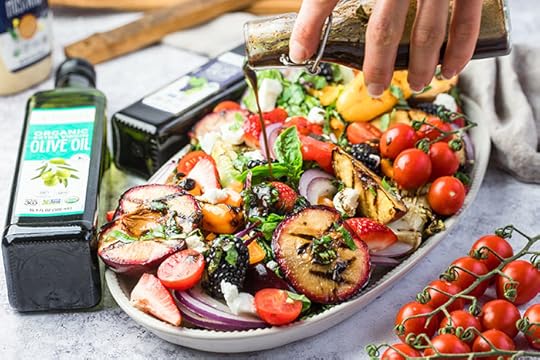 Have you ever made a grilled salad? You may think of salad as a cold food, but you’ll want to keep an open mind for this sweet, savory, smoky salad that’s just as refreshing as a cool, crisp salad on a hot day.
Have you ever made a grilled salad? You may think of salad as a cold food, but you’ll want to keep an open mind for this sweet, savory, smoky salad that’s just as refreshing as a cool, crisp salad on a hot day.
Hearts of romaine hold up well to the grill and develop a smoky wilt that balances out sweet grilled fruits and a tangy homemade balsamic dressing. This grilled romaine salad makes an excellent side dish that will become the star of any backyard barbecue.
To make it a main dish, grill your favorite chicken, steak, salmon or shrimp to top it with. Feel free to play around with the toppings to fit your diet or preferences. If you don’t have access to a grill, you can “grill” the lettuce, stone fruit and peppers on a hot cast iron grill pan on your stovetop.
Here’s how to make it.
IngredientsSalad3 heads romaine hearts2 peaches, plums or nectarines1/4 lb. baby bell peppers1/2 thinly sliced red onion1/4 lb. halved cherry tomatoes1/2 cup blackberries1/2 cup halved strawberries2 oz. crumbled goat cheese2 tbsp. thinly sliced basilavocado oilDressing1/4 cup olive oil3 tbsp. balsamic vinegar2 tbsp. thinly sliced basil1 tsp. dijon mustard1 clove grated garlicsalt and pepper
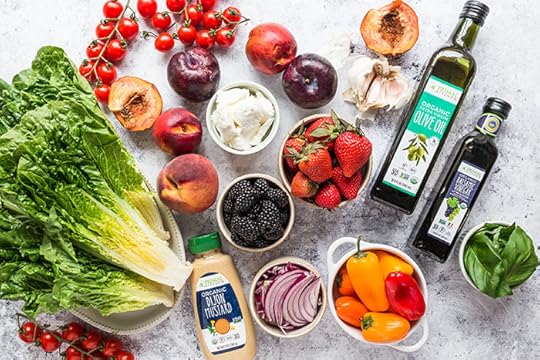
Slice your stone fruit in half or in slices. Carefully cut the romaine hearts vertically down the middle so you have 6 romaine halves. Make sure to keep the core intact. Toss the fruit, peppers, and romaine in avocado oil.
Preheat your grill to medium-high heat. Once hot, place the fruit and peppers on. Allow them to grill for a minute or so on each side before turning or flipping them. Continue until they have slightly softened and are grilled to your liking.
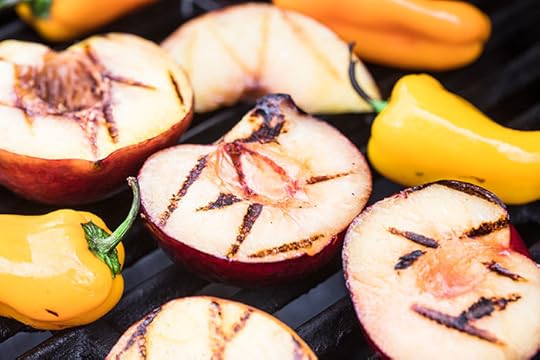
Place the romaine halves on the grill cut side down. Grill for a couple of minutes and then flip them over. They are finished when they wilt just a little and have a bit of char on them.
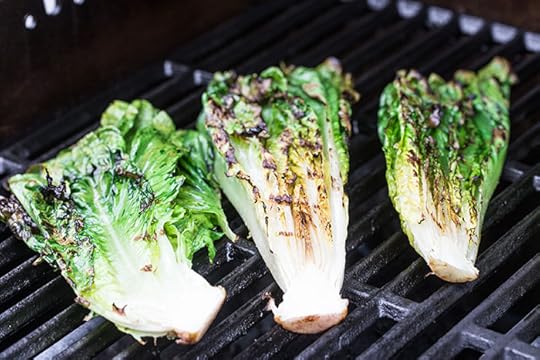
To make the dressing, whisk together the olive oil, balsamic vinegar, basil, mustard, and garlic. Season with salt and pepper to taste.
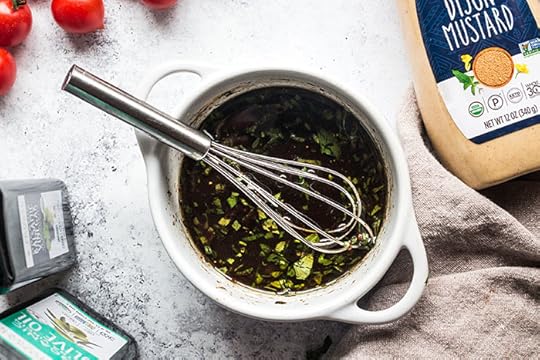
Arrange the romaine on a large platter or on individual plates. Stack the grilled fruit, peppers, fruit, onions and goat cheese on top. Sprinkle on the shredded basil and spoon on the dressing.

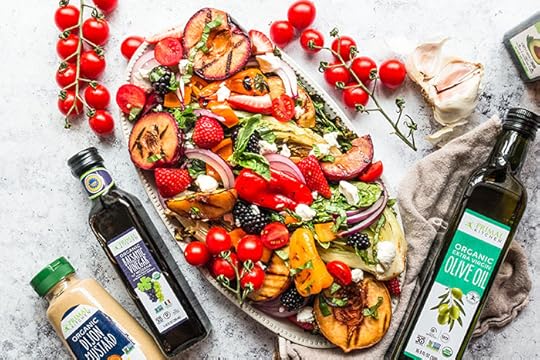
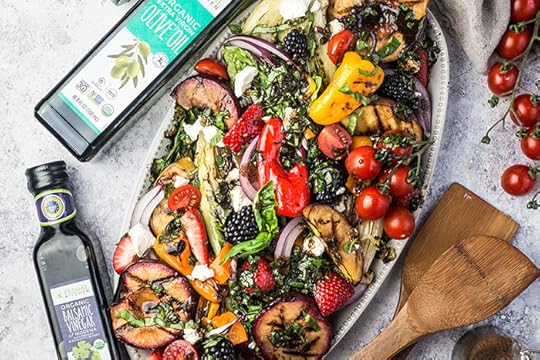
(function($) { $("#dfGpXI7").load("https://www.marksdailyapple.com/wp-ad..." ); })( jQuery ); 
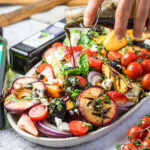 Grilled Romaine Salad Recipe
Grilled Romaine Salad Recipe ★★
2 from 1 reviews
Author: Mark's Daily Apple Prep Time: 5
Prep Time: 5  Cook Time: 10
Cook Time: 10  Total Time: 15 minutes
Total Time: 15 minutes  Yield: 4-6 servings Diet: Gluten Free
Yield: 4-6 servings Diet: Gluten Free  Print Recipe
Print Recipe  Pin Recipe Description
Pin Recipe Description Smoky-sweet salad made with grilled romaine, grilled vegetables, and grilled stone fruits.
IngredientsSalad
3 heads romaine hearts
2 peaches, plums or nectarines
1/4 lb. baby bell peppers
1/2 thinly sliced red onion
1/4 lb. halved cherry tomatoes
1/2 cup blackberries
1/2 cup halved strawberries
2 oz. crumbled goat cheese
2 tbsp. thinly sliced basil
avocado oil
Dressing
1/4 cup olive oil
3 tbsp. balsamic vinegar
2 tbsp. thinly sliced basil
1 tsp. dijon mustard
1 clove grated garlic
salt and pepper
Slice your stone fruit in half or in slices. Carefully cut the romaine hearts vertically down the middle so you have 6 romaine halves. Make sure to keep the core intact. Toss the fruit, peppers, and romaine in avocado oil.
Preheat your grill to medium-high heat. Once hot, place the fruit and peppers on. Allow them to grill for a minute or so on each side before turning or flipping them. Continue until they have slightly softened and are grilled to your liking.
Place the romaine halves on the grill cut side down. Grill for a couple of minutes and then flip them over. They are finished when they wilt just a little and have a bit of char on them.
To make the dressing, whisk together the olive oil, balsamic vinegar, basil, mustard, and garlic. Season with salt and pepper to taste.
Arrange the romaine on a large platter or on individual plates. Stack the grilled fruit, peppers, fruit, onions and goat cheese on top. Sprinkle on the shredded basil and spoon on the dressing.
 Category: Lunch, Dinner
Category: Lunch, Dinner Method: Grilling Nutrition Serving Size: 1/4 of recipe Calories: 288.1 Sugar: 15.5 g Sodium: 252.5 mg Fat: 20.6 g Saturated Fat: 4.4 g Unsaturated Fat: 15.18 g Trans Fat: 0 Carbohydrates: 22.5 g Fiber: 5.8 g Protein: 6 g Cholesterol: 6.5 mg Net Carbs: 16.53 g
Method: Grilling Nutrition Serving Size: 1/4 of recipe Calories: 288.1 Sugar: 15.5 g Sodium: 252.5 mg Fat: 20.6 g Saturated Fat: 4.4 g Unsaturated Fat: 15.18 g Trans Fat: 0 Carbohydrates: 22.5 g Fiber: 5.8 g Protein: 6 g Cholesterol: 6.5 mg Net Carbs: 16.53 g Keywords: grilled romaine salad, grilled salad, grilled fruit salad, gluten free salad, gluten free grilled
 Did you make this recipe?
Did you make this recipe? Share a photo and tag Mark's Daily Apple — we can't wait to see what you've made!
(function($) { $("#dfPdol4").load("https://www.marksdailyapple.com/wp-ad..." ); })( jQuery ); 
The post Grilled Romaine Salad Recipe appeared first on Mark's Daily Apple.



June 4, 2021
New and Noteworthy: What I Read This Week — Edition 133
 Research of the Week
Research of the WeekIn the absence of weight loss, there is no difference in blood glucose whether you’re getting 10% or 30% of dietary energy from carbs. In the study, 10% meant 65 grams of carbs per day or more.
Female chimps prioritize protein. Do you?
A survey of natural sounds, their benefits, and their distribution throughout National Parks.
In obese men, going keto preserves pancreatic beta-cell function and increases testosterone levels.
A genetic variant common among Southeast Asians may explain their low rates of COVID.
New Primal Blueprint PodcastsEpisode 497: Dr. Dale Bredesen: Host Elle Russ chats with Dr. Dale Bredesen about his research into Alzheimer’s.
Health Coach Radio: Erin and Laura chat with Mike Pullano, Chief Experience Officer at ARX (Adaptive Resistance Exercise).
Media, SchmediaNIH director likes the therapeutic potential of psychedelics.
This is why you must remove yourself from the modern environment and construct an ancestral one around you.
Interesting Blog PostsRangelands cover over half the world’s land surface.
Social NotesIt’s true. It’s all true.
Everything ElseMan who plans on manufacturing worms as a human staple food won’t eat them himself.
What the Oregon Trail pioneers packed.
Computers may be able to read images from brains within the decade.
Things I’m Up to and Interested In
This is why I walk: A simple walk after a can of coke mitigates the blood sugar spike.
Crazy thread: What kids are learning about nutrition in school.
Good news: If you’ve had COVID, you’ll probably make antibodies for life.
Important article: “The Lab-Leak Theory: Inside the Fight to Uncover COVID-19’s Origins”
What have I been saying for years?: The tangible health benefits of listening to nature sounds.
Question I’m AskingWhat are your health non-negotiables?
Recipe CornerLoaded cauliflower hummus.Great way to do filet mignon.Time CapsuleOne year ago (May 29 – Jun 4)
The Definitive Guide to Fats — All about fats.The Definitive Guide to Carb Timing and Carb Cycling — Make your carbs work for you.Comment of the Week
“re: Sunday with Sisson – One remarkable thing about life is that it seemingly opposes the increase in entropy/disorder that physics would normally associate with increases in heat and the passage of time. By moving and learning our bodies and brains become more ordered, and the efficiency with which they convert heat into work improves. This doesn’t violate the second law of thermodynamics because the total entropy of the universe still increases. The increase in the entropy of the environment exceeds the reduction in entropy associated with a more ordered state of brain or muscle structure and function. When we move, the entropy of the environment surrounding the muscles and nerves increases, so that ordered structures such as fascial adhesions do not form.
But this only happens if multiple systems interact in a complex manner – the logic doesn’t hold up if a joint lacks cartilage or synovial fluid, or if our diet lacks magnesium or something. The conversion of heat (calories) into internal order has its limits as well, because too much movement degrades our bodies. Things like life and optimal performance are only possible for a finite range of movement intensity, specific patterns of movement, and the right balance of dozens of dietary inputs. Bed rest and chronic cardio are both sub-optimal; too much or too little movement in a joint is sub-optimal; too much or too little of an essential nutrient is sub-optimal.
I think consciousness has evolved to detect deviations from optimality in these complex internal states and simultaneously adjust many internal components using comparatively simple behaviors – just move in a way that doesn’t cause too much pain, and eat the foods which appetite dictates (but obviously modern food chemistry, desk jobs, etc., mess this up). We all get the sense that we crave particular foods if we lack a particular nutrient, and this subconsciously drives our eating behavior. Primal folks like to avoid processed foods because they contain many calories and few nutrients, causing us to crave more food to get the nutrients that we need, which results in overeating and weight gain. Scientifically this is speculation, but there is some New and Noteworthy science here. Not sure if I can post links, but a search for ‘Response of the microbiome-gut-brain axis in Drosophila to amino acid deficit’ should produce a new paper that demonstrates the causal connection between a specific nutrient deficiency and an appetite for a specific type of food. Sure it’s drosophila, but presumably the mechanism is similar in humans, and to my knowledge it’s the first such demonstration of the sort in any species. So yeah, you could consider movement the key to everything in life because without it you’d be dead, and stuff breaks if you turn it too hard, but like diet and social interaction, it’s just one key on the chain.”
-Nice comment from Investigator.
(function($) { $("#dfeb2N2").load("https://www.marksdailyapple.com/wp-ad..." ); })( jQuery ); 
The post New and Noteworthy: What I Read This Week — Edition 133 appeared first on Mark's Daily Apple.



Mark Sisson's Blog
- Mark Sisson's profile
- 199 followers



